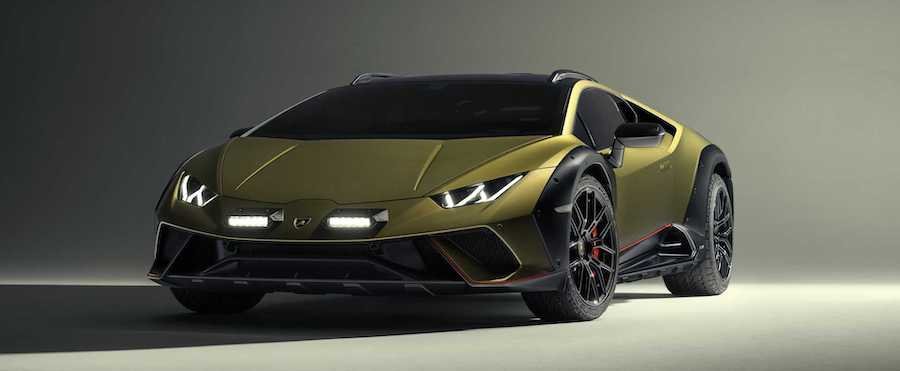Lamborghini unleashes 601bhp off-road Huracan Sterrato

Lamborghini has revealed the production-ready Huracán Sterrato, an offroad-ready swansong for its V10 supercar, ahead of the arrival of a new plug-in hybrid successor in 2024.
The final Sterrato has made its debut just two weeks after Porsche’s similarly conceived Porsche 911 Dakar headlined at the Los Angeles motor show, but it is in effect an evolution of a concept first shown in 2019.
Reaction from potential customers was overwhelmingly positive, but company insiders say it took the return of Stephan Winkelmann to the role of Lamborghini CEO in 2020 for the production version to get the green light.
The finished Sterrato, which is due with customers next year, looks very similar to the original concept, with carbonfibre bodywork extensions, a raised ride height, integrated auxiliary driving lights and roof bars, but numerous small tweaks have been made to prepare it for production. The most obvious is the arrival of a roof-mounted air intake for the V10 engine. This is not to enable wading but to find cleaner air in the dusty off-road environments for which the car is designed.
Lamborghini’s engineers also experimented with keeping the original intakes behind the rear side window, with small protection plates to help deflect flying stones. Ultimately, these were not judged effective enough for the production version, hence the switch to a ‘snorkel’ instead.
The revised intake system is the main reason that power from the naturally aspirated 5.2-litre engine has fallen slightly compared with other Huracán models: the Sterrato’s V10 makes 601bhp (compared with 632bhp for the new Tecnica), although the 413lb ft torque peak is unchanged. That results in a claimed 0-62mph time of 3.4sec, this while running on the standard Bridgestone Dueller All-Terrain 002 tyres. The chunkier rubber is also why top speed has been limited to 160mph, which is lowest top speed of any Lamborghini since the monstrous LM002 off-roader went out of production.
The Sterrato uses the same seven-speed dual-clutch automatic gearbox and allwheel drive system as the Evo AWD, but it does without the powered rear-axle steering that it had as standard. “On dirt, there isn’t any point,” said Rouven Mohr, Lamborghini’s CTO. Mohr also confirmed that the Sterrato has a Rally mode, like that on the new Urus Performante. This doesn’t disengage drive to the front axle but slackens off stability control intervention to allow both large and sustainable oversteer angles, though it will step in if the car starts to spin.
The Sterrato has been designed for sand and gravel rather than hardcore rock scrambling. Ground clearance has been increased by 44mm over the regular Huracán, with additional underbody protection and reinforced sill plates. Carbonfibre wheel-arch extensions also cover a slightly widened track at each end (up by 30mm at the front and 34mm at the rear). Suspension settings are softer, and the 40-section tyres have been chosen to help protect the 19in alloys from damage.
Two of the most distinctive details were hardest to realise. The front auxiliary lights have to meet US pedestrian impact requirements, and in order to fit the roof bars, which are rated to a modest 30kg, strengthening had to be added to a part of the Huracán’s structure that was never designed to carry loads.
Lamborghini will make 900 Sterratos, quoting a European market price of €263,000 (£228,000) before taxes. That’s roughly £55,000 more than its closest conceivable rival, the 911 Dakar, but undercuts the track-focused Huracán STO by more than £30,000.
How the Sterrato started with Rouven Mohr and Mitja Borkert
Lamborghini chief technical officer Rouven Mohr: “We started talking about it just after we had both started working at Lamborghini. We were talking about the cars we love and we got onto the Lancia Stratos. Then I took an old durability development car and created the original concept. That’s why it’s wearing something like Alitalia livery, although we changed the colours before we showed it!
“The driving experience will be very different. The suspension is softer and there is rolling and pitching – things we try to minimise with a sports car. It’s really like a rallycross car. It was challenging from a tyre point of view to have a set-up that was also stable at speed.”
Lamborghini design boss Mitja Borkert: “I’ve always loved the idea of putting a super-sports car into an unexpected environment. But the concept is so simple that everybody got it immediately, and customers were really enthusiastic. But Stephan Winkelmann deserves the credit for saying ‘yes’ when he came back to the company, because this is definitely not a traditional Lamborghini.
“It was during testing that we discovered we needed the air scoop: the engine was eating too much dust, or rather the filters were getting blocked too quickly. It has been designed for real off-road use; it needs to be able to take it. And I hope that people will find opportunities to drive it like that. It is going to look better when it is dirty, or even when it has some wear on it.”


Related News


